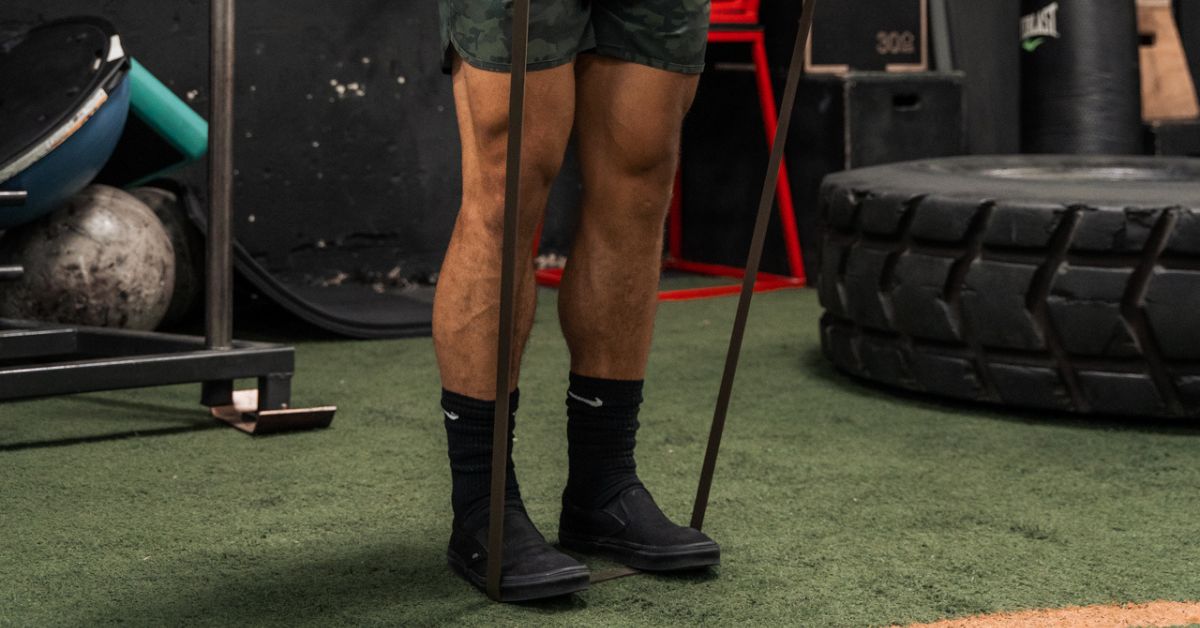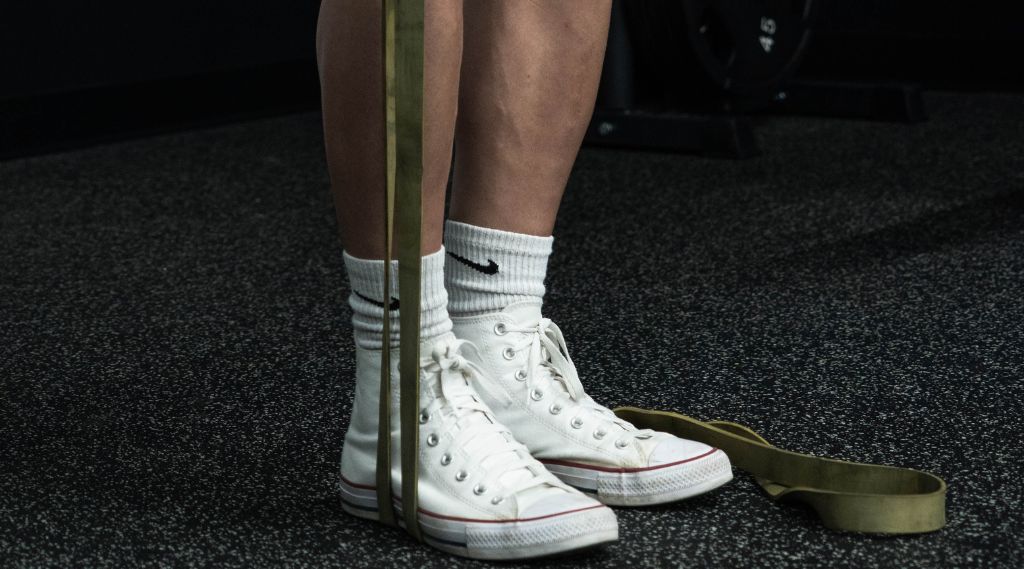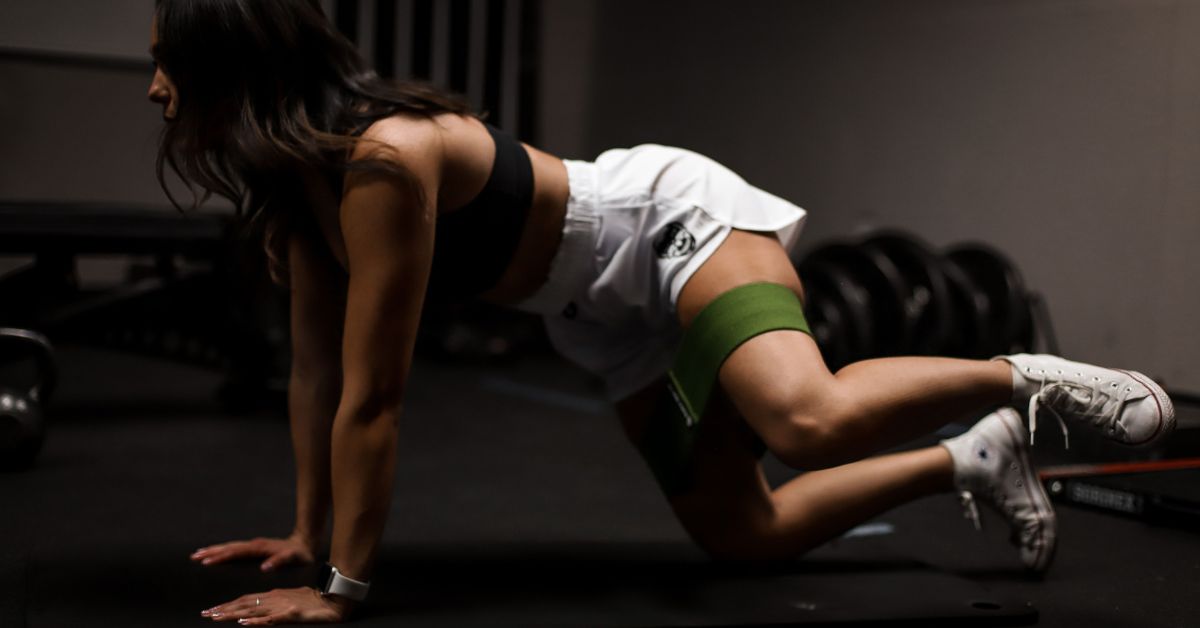If you’re working out with limited equipment, then you may struggle to think of exercises that will target your hamstrings. Luckily, there are multiple exercises you can do with resistance bands that will help strengthen and grow your hamstrings.
So what are some good hamstring exercises with bands? Some of the best hamstring exercises with bands include the seated and lying hamstring curl, good mornings, Romanian deadlifts, glute bridges, and donkey kicks. Using bands for these movements can improve hamstring activation and growth with limited equipment.
I’ll teach you how to perform each of these movements correctly and show you how you can combine them to build an effective hamstring workout.
Key Takeaways
- The hamstring group consists of three muscles: the semitendinosus, biceps femoris, and semimembranosus. Their functions are knee flexion and hip extension.
- Your hamstring workout should include exercises that require you to bend at the hip and the knees to target all of the hamstring muscles.
Anatomy of the Hamstring Muscles
The hamstrings are the muscles that make up the posterior portion of the thighs. They span from just below the buttocks to the knees.
Because of their origin (bottom portion of the pelvis) and insertion (the knee), the hamstrings are involved in knee flexion (bending the knee) and hip extension (driving your hips forward, such as when standing up).
Though most people see the hamstrings as single units, three muscles make up that group: the biceps femoris (which has a short and long head), semitendinosus, and semimembranosus.
The three muscles work together during all hamstring activities but certain exercises can target different hamstring muscles more effectively than others, which is why it’s important to understand their functions.
For example, the biceps femoris has two heads; the long head crosses the hip and knee joints, allowing it to assist with knee flexion and hip extension. However, the short head doesn’t cross the hip joint and only contributes to knee flexion.
Benefits of Training Hamstrings With Bands

Here are several impressive benefits of training your hamstrings with resistance bands:
Better muscle activation
Resistance bands can promote better hamstring activation because they provide constant tension. The resistance grows progressively as the band stretches, forcing you to contract your muscles harder to complete each repetition.
Muscle and strength gain
Bands are highly beneficial for hypertrophy and strength gain because they provide an opportunity to progressively overload your muscles, which is crucial for your muscles to adapt.
“If you’re looking to gain muscle size and strength, you can use bands in place of dumbbells and machines to provide a new and challenging stimulus to your muscles for growth. You can also add them to barbell exercises to increase intensity and neuromuscular performance.”
- Holly Pinkham, CPT, and nutrition coach
One simple option is to start with the lightest band in this set (20-35 lbs of resistance) and progress to the 2nd lightest (30-60 lbs of resistance), working your way up through the bands as you get stronger.
Multiple exercise options
Bands are a fantastic workout tool because trainees can pick from many effective exercises for all the major muscle groups, including the hamstrings (we’ll go over the best banded hamstring exercises next).
Train at home or on the road
You can grab a resistance band set and have effective hamstring workouts at home, outside, and on the road which makes it easier to be consistent with your workouts.
Related Articles:
- Best Hamstring Kettlebell Exercises + Sample Workout
- Best Calf Exercises With Resistance Bands (+ Sample Workout)
9 Best Hamstring Exercises With Bands
1. Seated Hamstring Curl
Seated hamstring curls target all the hamstring muscles, including the short biceps femoris head. The movement is traditionally done on a gym machine, but you can replicate the movement using a resistance band and a bench or chair.
How To Do Seated Hamstring Curl
- Secure a looped band somewhere low, like a post, squat rack, or on a door using a resistance band door anchor.
- Grab the opposite end of the band and tie it over your feet, just above the heels.
- Take a few steps back while facing the band and sit on a bench or chair. The band should be stretched to some degree.
- Puff your chest out, engage your abs, and inhale.
- Bend your knees to pull the band toward you against the resistance in one fluid motion, squeezing your hamstrings.
- Slowly extend your knees as you exhale.
- Repeat for the desired number of repetitions.
Pro Tip: Pull the band back as far as you can, ideally past the 90-degree angle at your knees, to get a full range of motion and activate your hamstring muscles more effectively.
2. Lying Hamstring Curl
Lying hamstring curls are an isolation exercise typically done on a gym machine, but you can also set this up with a resistance band to perform the movement at home or when you have limited equipment available.
How To Do Lying Hamstring Curl
- Secure a looped band somewhere low, like a post, squat rack, or on a door using a resistance band door anchor.
- Lay down on your stomach, facing away from the band. Put your feet through the band and bend your knees slightly so that the band is looped around the ankle/calf area.
- At this point there should be tension on the band; if there’s not enough tension on the band, move further away from it.
- Pull your feet toward you, as if you were going to touch your feet to your glutes, and squeeze the hamstrings against the band resistance.
- Slowly lower back to the starting position. Repeat for the desired number of repetitions.
Pro Tip: Use a lighter resistance band that allows you to do smooth repetitions with a full range of motion instead of jerking your legs to achieve knee flexion.
3. Band Glute Bridge
Glute bridges are a classic exercise that targets the glutes and hamstrings, but you can shift more emphasis to the hamstrings by positioning your feet further away from the glutes than you normally would.
This variation of the banded glute bridge involves wrapping the band around your feet to create more tension at the hips and hamstrings; not to be confused with the glute bridge + hip abduction which uses a hip band and targets the glute abductors.
How To Do Band Glute Bridge
- Sit on the ground with your knees bent and take a loop band and wrap one end of the band around each foot.
- Grab the middle of the resistance band and pull it up so it is resting on your hips as you lie back. Your lower back and your feet should be flat on the floor, and your knees should be bent at around 90 degrees.
- Take a deep breath, engage your abs, and initiate the repetition by pushing through your heels and squeezing your buttocks.
- Lift your hips toward the ceiling until they align with your shoulders and knees.
- Pause briefly at the top and slowly lower your butt to the floor as you exhale.
Pro Tip: Don’t over-arch your lower back at the top of the rep, your spine should be neutral throughout the movement. If you’re worried about the band sliding off your hips, then feel free to keep your hands on it to hold it in place.
4. Single-Leg Glute Bridge
The single-leg glute bridge is a more advanced version for people who find the classic movement too easy even with the use of a resistance band.
How To Do Single-Leg Glute Bridge
- Loop both ends of a band around your foot and plant your foot on the floor to anchor them in place.
- Grab the middle of the resistance band and pull it up so it is resting on your hips as you lie back. Your lower back and your feet should be flat on the floor, and your knees should be bent at around 90 degrees.
- Take a deep breath, engage your abs, and bend the opposite knee (the one not anchoring the band) toward your chest.
- Initiate the repetition by pushing through your heel and squeezing your buttocks. Lift your hips toward the ceiling until they align with your shoulders.
- Pause briefly at the top and slowly lower your butt to the floor as you exhale.
- Switch sides, and repeat.
Pro Tip: Focus on pushing through the heel of the foot that is planted to lift your hips off the floor. If you’re struggling to feel this in your hamstrings, then try having the foot that’s anchoring the band a bit further away from your body.
5. Band Good Morning
The banded good morning is a compound hip hinge movement that trains the posterior chain: hamstrings, glutes, and back.
How To Do Band Good Morning
- Grab a looped resistance band and step over one side with your feet hip-width apart.
- Squat down and pull the opposite end of the band to place it on top of your shoulders, just behind your neck. Hold the band with both hands.
- Stand tall, take a deep breath, and squeeze your abs.
- Hinge at the hips by slowly leaning your torso forward and bringing your buttocks back while maintaining a neutral spine (no arching or rounding of the spine).
- Lower your torso until it is nearly parallel to the floor and you feel a stretch in your hamstrings.
- Pause briefly and push your hips forward to stand up as you exhale.
Pro Tip: Focus on pushing your hips behind you as your torso comes forward so that you can maintain a neutral spine. If this is new to you, then set up about a foot from a wall and focus on pushing your butt back to touch the wall as you perform the movement.
6. Band Romanian Deadlift
Banded Romanian deadlifts are similar to good mornings, with the primary difference being that you’re holding the band with both hands in front of your thighs instead of placing it over your shoulders.
How To Do Band Romanian Deadlift
- Take a looped resistance band and step over it with both feet, having them hip-width apart.
- Squat down and grab both ends of the band (one end in each hand).
- Puff your chest out, engage your abs, and inhale.
- Press through your heels to extend your hips and straighten your legs to come to a standing position. The band should be almost maximally stretched in that position.
- Take another breath and lean your torso forward as you push your buttocks back to maintain a neutral spine.
- Descend until you feel a significant stretch in your hamstrings (approximately mid-shin), and drive your hips back underneath you to stand back up. Exhale.
Pro Tip: There should be some bend tension even as your torso becomes parallel to the floor. A foot stance slightly more than hip-width apart can stretch the band more, providing additional resistance.
However, if one band doesn’t provide enough tension, then you may have to use two resistance bands to increase the difficulty.
7. Band Deadlift
The band deadlift is an effective full-body exercise you can do at home to develop your hamstrings and build strength. With the band deadlift, you’ll want to use more resistance than you do in the Romanian deadlift as this is typically a stronger position.
How To Do Band Deadlift
- Take a looped resistance band and step over it with both feet, having them hip-width apart.
- Squat down and grab both ends of the band. Straighten your arms and have them to your sides.
- Puff your chest out, engage your abs, and take a breath. Your shoulders should be slightly in front of your toes and your spine should be neutral (not arching or rounding).
- Push through your heels and pull both ends of the band, extending your knees and hips to come to a standing position.
- Slowly reverse the movement by hinging at the hips and bending your knees to return to the starting position.
Pro tip: You can start with a single, looped resistance band, but the tension might not be enough to provide the necessary overload. Consider using two or even three bands simultaneously to increase the resistance.
8. Resistance Band Donkey Kick
Donkey kicks primarily train the glutes but are also fantastic for working the hamstrings.
How To Do Resistance Band Donkey Kick
- Wrap a hip band over your thighs, an inch or two above your knees.
- Get down on all fours with your knees bent, arms straight, and hands flat on the ground.
- Bring your shoulders back, take a deep breath, and squeeze your abs.
- Lean slightly to the left and kick your right leg back in one fluid motion. Your heel should point to the ceiling at the top position.
- Bring your leg to the starting position as you exhale.
- Once finished training that side, lean to the right and perform the same number of reps for your left leg.
Pro Tip: Aim for 20-25 smooth and controlled reps per side. Squeeze your glutes and hamstrings at the top position to ensure optimal muscle activation.
9. Banded Hamstring Marches
While not as popular, hamstring marches train the posterior chain quite well. Additionally, the exercise works the glutes and forces a strong isometric contraction in the midsection.
How To Do Banded Hamstring Marches
- Attach a light loop band somewhere low.
- Sit on the floor, facing the band, and loop it over both feet.
- Bend your knees to stretch the band and create some tension.
- Flex your glutes and raise your buttocks several inches off the floor.
- Inhale and slowly ‘march’ your feet toward the band, one step at a time, extending your knees by a few degrees.
- Walk your feet back to the starting position.
- Keep moving back and forth until you’re done.
Pro Tip: Flex your abs at the start of the set and maintain tension to keep your spine in a safe and healthy neutral position. Raising your buttocks off the floor will naturally cause you to arch your lower back, and you must resist that position because it can lead to aches in the area.
Sample Hamstring Workout Routine With Bands
Here is a resistance band hamstring workout using four exercises from above:
|
Exercise |
Sets |
Reps |
Rest Period |
|
Band Romanian Deadlift |
3-4 |
8-15 |
120-150 seconds |
|
Single-Leg Glute Bridge |
3 |
12-20 |
90-120 seconds |
|
Banded Hamstring Marches |
3 |
8-10 (in+out=1) |
90-120 seconds |
|
Lying Hamstring Curl |
2-3 |
To failure |
90-120 seconds |
Feel free to replace one hamstring exercise with similar ones listed in the exercises above.
For example, you could trade the Romanian deadlift for the regular deadlift, the single-leg glute bridge for the regular glute bridge, and the lying hamstring curl for the seated hamstring curl.
Best Bands For Training Your Hamstrings
I recommend two resistance band products for optimal hamstring training: the Gymreapers Hip Bands and Military Resistance Band Set.
Hip bands are ideal for lower body training. The objective is to loop one over your lower legs or thighs and perform various activities. A band wrapped around your legs provides additional resistance, making even simple movement patterns more challenging.

For example, as you saw above, you can wrap a hip band over your thighs and make donkey kicks more challenging.
These bands are made of premium elastic material that lasts a long time and isn’t likely to slip during an intense set. Plus, given their low price and the one-year replacement guarantee Gymreapers offers, it’s a win-win.
Next, we have the military band set. I recommend these bands because they allow you to do countless exercises for all the major muscle groups, including the hamstrings, and you can pick from multiple resistance levels.

The lightest band in the set offers 20 to 35 lbs of resistance, but the thickest one goes up to 150 lbs, which is sure to give anyone a good workout.











Hinterlasse einen Kommentar
Alle Kommentare werden vor der Veröffentlichung geprüft.
Diese Website ist durch hCaptcha geschützt und es gelten die allgemeinen Geschäftsbedingungen und Datenschutzbestimmungen von hCaptcha.